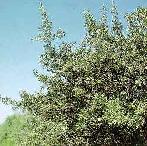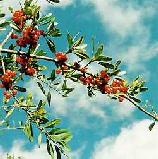

Silver Buffaloberry
Shepherdia argentea (Pursh.) Nutt.
The Silver Buffaloberry is a native, deciduous, thicket-forming small tree or large shrub with spreading to ascending thorny branches. It grows up to 20 feet tall with silvery, willow-like leaves and thorn tipped twigs. Leaves are about 1 to 2 inches long and 1/4 to 1/2 inch wide. It's bright red or orange berries are sour but edible.. It's sprouts originate from a complex network of underground stems and rootstocks. It also sprouts from the root crown. The fruit look slike a small orange-red currant, but it grows attached to the branch. It flowers in May through July. Shrubs are interconnected for distances of up to 20 feet. Silver Buffaloberry occurs in riparian areas such as wet meadows, floodplains, terraces, and along streams, rivers, lakes, springs, and ponds. The plant grows best on moist to semi-wet soils with good drainage, but will grow in semi-shaded areas and on dry, exposed hillsides. It grows best on loam and sandy loam soils, but occurs on clay, clay loam, and gravelly substrates as well. Silver Buffaloberry is tolerant of poorly drained soils and some flooding, but is intolerant of prolonged flooding and permanently high water tables.
Food Use:
The fruit may be eaten raw or dried for winter use. The taste is
sour and to some people bitter. It may also be to make juice. Plains Indians and pioneers preserved the fruit
of silver buffalo berry and made a sauce from the berries that was eaten with
bison meat. Today the fruit is used to make pies, jams, and jellies.
Value for Wildlife:
Silver buffalo berry is a valuable forage species for mule deer, pronghorn,
and grizzly bear. In the northern Great Basin, deer and elk browse silver
buffalo berry. In the northern Great Plains, the fruit of silver buffalo
berry provides the best native winter food source for sharp-tailed grouse. (Source)
Planting:
Silver buffalo berry is difficult to transplant
from its native habitat. For field transplanting, root cuttings will give best
results. Silver buffalo berry sprouts originate from a complex network of
underground stems and rootstocks. It also sprouts from the root crown. Shrubs
are interconnected for distances of up to 20 feet.
 t
t